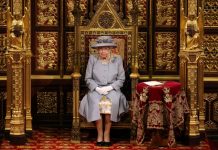 On May 13th , 2020, the Supreme Court, as a precautionary measure to contain the spread of Corona virus infection, has relaxed the dress code for Advocates appearing before it through video conferencing. Now the “advocates may wear “plain white shirt/white-salwar-kameez/ white saree, with a plain white neck band” during the hearings before the Supreme Court of India through Virtual Court System till medical exigencies exist or until further orders.” The court has temporarily done away with the requirement of wearing gowns, for the time being. The directions will come into force with immediate effect. This diktat from the Apex Court comes as a soothing breeze to the legal fraternity after having lost in all the legal avenues to get emancipation from the colonial dress code.
On May 13th , 2020, the Supreme Court, as a precautionary measure to contain the spread of Corona virus infection, has relaxed the dress code for Advocates appearing before it through video conferencing. Now the “advocates may wear “plain white shirt/white-salwar-kameez/ white saree, with a plain white neck band” during the hearings before the Supreme Court of India through Virtual Court System till medical exigencies exist or until further orders.” The court has temporarily done away with the requirement of wearing gowns, for the time being. The directions will come into force with immediate effect. This diktat from the Apex Court comes as a soothing breeze to the legal fraternity after having lost in all the legal avenues to get emancipation from the colonial dress code.
Needless to say that dress code is a symbol of confidence, a symbol of discipline and a symbol of the profession, a proud part of a lawyer’s personality as a professional. India in
terms of Lawyer’s dress code traces its legacy from British rule with some minor modifications made at times. The Advocate’s Act of 1961 makes it mandatory for a lawyer to wear a black robe or coat with a white neckband on top of it in the continuity of the same. The dress of an Advocate serves a very useful purpose. In the first place, it distinguishes an Advocate from a litigant or other members of the public, who may be jostling with him in a Court room. When a lawyer is in prescribed dress his identity can never be mistaken. However, lawyers from both the sides, the petitioner and the respondent, wear a similar dress code.
Since independence, a large section of legal fraternity had been agitating by filing cases against the rigours imposed by the dress code and its unsuitability in the diverse climate
conditions throughout the length and breadth of this country. It was pleaded that what was relevant in a cold climate like that of the U. K., the same could not work in a hot climate like ours. In 2014, 2016 and 2017, lawyers in jurisdictions of Madras and Calcutta High Courts, agitated that due to sweltering heat in their regions, they should be exempted from wearing black coats during the months of summer as was the practice in Punjab & Haryana High Court jurisdiction. This was ultimately acceded to.
The dress code as per the Bar Council Regulations, mandates that the advocates appearing in the Supreme Court, High Courts, Subordinate Courts, Tribunals or Authorities, to appear sober and dignified, wear prescribed white and black dresses with white bands or black tie. Wearing of Advocates’ gown shall be optional except when appearing in the Supreme Court or in High Courts. Except in Supreme Court and High Courts, during summer wearing black coat is not mandatory. An unfounded obsession with the formal dress code compelled certain courts to literally hold that appearing without the prescribed dress was to show disrespect and as such the Court was certainly entitled to refuse audience. Courts insisted that the formal attire associated with certain professions and the utility and necessity of ceremonial dress is recognized in many countries, hence the prescribed dress code must be followed.
Various High Courts and even the Supreme Court repelled all such attempts by holding that no doubt rules framed by the Bar Council make it imperative for an Advocate to appear in Court at all times only in the prescribed dress, yet the power to preclude an Advocate from appearing in Court is by necessary implication vested in that Court in order to enforce the observance of the prescribed dress. The present article captures the journey of lawyer’s dress code. Black and white are considered symbols of the legal profession throughout world barring few exceptions. Black colour on the positive side signifies the strength and authority and the white colour signifies light, goodness, innocence, and purity.
Legal system is looked upon as the only hope of justice for a common man, the colour white is chosen to represent him. Advocate’s white bands represent the upholding of the laws of God and of men. This is followed by all countries based on Anglo-Saxon Jurisprudence, where it is widely believed that the dress induces a seriousness of purpose and a sense of decorum which are highly conducive to the dispensation of justice. In the United States, however, the attorneys appearing before the court are required to wear a conservative business dress only.
Under the Advocates Act, 1961, two classes of advocates are recognized, Senior Advocates and other Advocates. While the rule framed by the Bar Council of India does not make out any distinction in dress or prescribe the design of a different gown or coat for a senior advocate, yet the distinction has been maintained and followed by a practice of long-standing, even prior to the Advocates Act of 1961. Conscientious sections among the lawyers have pleaded even before the Apex Court that the rules under the Advocates Act did not distinguish between “seniors” and other advocates as far as their dress was concerned. The senior advocates wear twin coats with gowns which is slightly different from those worn by other advocates, though the use of such coats and gowns by the senior advocates was illegal as no tradition could override a statute, unless specifically provided for by law enacted by the Parliament.
Since the right to designate an Advocate as a Senior Advocate vests only with the High Courts and the Supreme Court, therefore, to preserve their own right to confer a sort of title (notwithstanding what the Article 18 stipulates), the courts, for the reasons known to themselves only, have recognized a distinct class among the Advocates, which as per the Court, constitute a different class within the advocates. Based on the ability, knowledge, experience, expertise and standing at the bar, an advocate is designated as a senior advocate. In view of the Court it was an honour and distinction conferred by the court itself in “recognition of the ability and standing” (?) of the concerned advocate. Therefore, the wearing of a distinct gown or a coat by a senior advocate, which is different from the one worn by advocates, cannot be questioned or assailed as discriminatory or violative of Art. 14 of the Constitution of India.
The Senior Advocates, so designated by the Court, are given a special right of audience (right to be attended to) by the Court in preference to other Advocates. As a harsh ground reality only the designated Senior Advocates take almost the whole working time of the Court by their acts, which includes shenanigans like PILs etc., thus filling their own coffers at the expense of less fortunate class of “other Advocates”. The traditional dress code has led to a situation where one class of professionals with the same academic qualifications and the same experience is overfed while the other is under nourished by a quirk of dress code. Now that Legal Professionals stand emancipated by the benign effect of Covid-19, it is hoped and prayed that the dress now prescribed by the Apex Court on ad-hoc basis, shall become a permanent feature of the Indian Courts.












